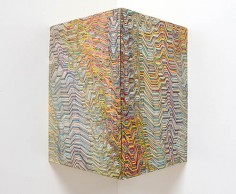Paul Sharits
source: burchfieldpenneyorg
Paul Sharits was born in Denver, Colorado and earned a BFA in painting at the University of Denver’s School of Art where he was a protege of Stan Brakhage. He also attended Indiana University in Bloomington, Indiana where he received an MFA in Visual Design. In July 1960, he married Frances Trujillo Niekerk, and in 1965 they had a son, Christopher. They divorced in 1970.He was subsequently a teacher at the Maryland Institute College of Art, Antioch College, and, from 1973 to 1993, the State University of New York at Buffalo.
Sharits is recognized internationally as a pioneering experimental filmmaker; however, he was trained as a painter and adapted strategies from both disciplines in his work. His influence on audiences worldwide was very apparent during his life.
Beginning in the 1960s, Sharits utilized structuralist theory and painting strategy to create non-narrative, non-objective works he called “flicker films” that were about the elements of film itself. He became a master of intercutting one medium with the other, using linear film structures in his painting and planning his films with scores, conceived as colored ink drawings on grid paper. His Frozen Film Frame Series showed this process in reverse as two-dimensional, post-production renderings of his films. In these works, strips of film are sandwiched between two sheets of Plexiglas, which when lit are reminiscent of stained glass windows. Sharits later integrated individual words, polemic texts, soundtracks, and surreal meaning into his films and paintings, concurrent with his association with the Fluxus movement. His multiple projector installations during the 1970s in museums in New York City, Buffalo, and throughout Europe changed how the public perceived film.
Sharits came to Buffalo in 1973 to join filmmakers Hollis Frampton, James Blue, and Tony Conrad in the Center for Media Study at the State University of New York at Buffalo. He also befriended Gerald O’Grady, the founding director of Media Study/Buffalo, a community-based organization and regional center established in 1971 “to encourage the creation and understanding of media – especially photography, film, and videotape- by people of all ages.” [1] O’Grady later became director of the University’s Center for Media Study. He regarded Sharits as “one of the true masters of modern film … Of all the filmmakers in history, he is the most painterly. His film derives from painting’s texture and visual design … It is not about the camera. Nor is it about editing. It is about light, color, visual texture, and design.”
Sharits’s work of the 1980s often reflected a tortured persona, as he experienced a series of accidents and assaults, including being stabbed in the back and nearly fatally wounded by a gunshot. Nevertheless, he thrived on challenging society and its preconceptions of art and film through his work, his underground lifestyle, and his notorious soirées that encouraged a dialogue on current advances in the field.
.
.
.
.
.
.
.
source: bcubico
Paul Sharits (1943-93) é um dos pioneiros do cinema expandido. A obra do cineasta americano amplia a prática do cinema para além das formas usadas, com telas múltiplas e instalações desde os anos 60. Seu trabalho interroga tanto as condições de produção de um filme, em uma aproximação ontológica (fita, fotograma, obturador), quanto as relações que mantemos com a imagem projetada (cinema, sala de exposição). O trabalho cinematográfico de Paul Sharits não pode ser pensado fora de uma prática que explora os fenômenos da nossa percepção, assim como o seu prolongamento plástico no espaço da projeção (telas múltiplas, instalação). Esta interrogação se efetua de acordo com diferentes eixos que articulam e alternam, na sua produção, uma abordagem formal (analítica) à outra mais emotiva. A cor tem aqui um papel essencial: ela induz, produz estados perceptivos que nos perturbam e nos fascinam.
Paul Sharits inicia seus trabalhos com a pintura, antes de fazer filmes. Se os primeiros filmes foram um pouco narrativo, rapidamente o cineasta desenvolvia um cinema da percepção, os filmes trabalham a estabelcer uma ontologia do cinema. Seus trabalhos cinemátograficos vão ampliar o cinema fora do lugar do teatro para investir nas paredes das gallerias com as Instalações e os Frozen Film Frames. A primeira instalação que ele fez foi : Sound Strip Film Strip em 1972, e os Frozen Film Frames foram mostrados a partir de 1976. Os Frozen Film Frames são quase partituras dos filmes, se pode ver o filme em sua totalidade de uma vez, mais também pode-se explorar cada quadro de cor que não se pode sentir assim quando são projetados. O Frozen Film Frame é uma suspensão do tempo, uma parada do fluxo e da linearidade do filme. Se nos pensamos ao Frozen Film Frame (quadro de película) como a uma partitura, podemos entender porquê e como Paul Sharits vai voltar aos desenhos para pensar as notações dos filmes e depois voltar a pintura nos anos 80. A partir da metade dos 70 a produção de esboços com múltiplas variações são estudos para os Frozen Film Frames ou para os próprios filmes.
A esposição traz 11 desenhos, partituras, estudos para Frozen Film Frames, Frozen Film Frames (quadro de película), uma instalação e alguns filmes.


